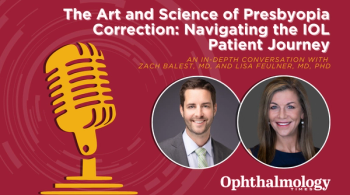
Five-year study of PRK-treated eyes finds no evidence of MMC toxicity
Seoul, Korea-Intraoperative use of mitomycin-C (MMC) is a safe and effective method for preventing corneal haze in eyes undergoing PRK, said Dongho Lee, MD, PhD, director, Yonsei Eye Center, Seoul, South Korea.
"After an average follow-up of more than 5 years for 115 eyes treated with this regimen and including safety evaluations with endothelial cell counts and confocal microscopy, we have seen no severe complications related to MMC toxicity," he said.
The study group consisted of 51 women and eight men who were treated for a mean preoperative spherical equivalent (SE) of –8.0 D (range, –2.6 to about –15 D). The minimum follow-up was 58 months, and it ranged up to 6 years.
"The wound is irrigated because the corneal bed is usually very dry after the ablation and direct application of MMC can result in unwanted deep penetration. Therefore, our technique is to irrigate the bed, wipe the wound margin, and when applying the MMC, we use another ring-shaped Merocel sponge to reduce contact surface area and to improve patient fixation," Dr. Lee explained.
The refractive outcomes have shown overall good stability and accuracy. Mean SE was –0.11 D at 1 year and decreased to –0.60 D at 5 years. At last follow-up, the SE was within 0.5 D of intended in 74% of eyes.
"Sixteen percent of eyes in the study group had more than 1 D of regression," Dr. Lee reported.
Only 86% of eyes had a preoperative best-corrected visual acuity (BCVA) of 20/25 or better. Postoperatively, uncorrected visual acuity (UCVA) was 20/20 or better in 66% of eyes and 20/30 or better in 84%.
Minimal complications
Complications have been minimal. Epithelial healing was delayed for 10 days in a single eye but progressed thereafter without any associated problems. Corneal haze developed in only six eyes (5%) but was rated as grade 1 in five of those cases and grade 2 in the other.
"The corneal haze faded slowly and by the third year after surgery had cleared in all eyes that had grade 1 haze. The case of grade 2 haze became grade 1. However, the haze was also associated with myopic regression, and four eyes underwent enhancement," Dr. Lee said.
Newsletter
Don’t miss out—get Ophthalmology Times updates on the latest clinical advancements and expert interviews, straight to your inbox.


















































.png)


